Do you want to see a Roman temple in London? Well, start off on Queen Victoria Street, with the Bank of England behind you. Head south down Walbrook towards Cannon Street. You’ll pass Starbucks on your left, and the Bloomberg building on your right. But look closer at the shining office block as you pass.
Beneath this temple of commerce lies a lost Temple of Mithras, otherwise known as a Mithraeum. More than 400 Mithraea have been found across the land once held by the Roman Empire (Wolfe 2017). This one just happens to be in a more ‘central’ location.
Come on! Let’s take a look.
A Brief History of the London Temple of Mithras
The London Mithraeum lies seven metres below the entry space inside Bloomberg London. A timeline on the staircase shows you the different street levels at various points in history.

If you’re wondering how street levels change, wonder no more! It tends to happen when soil shifts and people don’t remove building debris. Gradually it builds up and the streets get higher up.
Anyway. The Romans built the temple on the banks of the Walbrook River in c. 240 AD. The Walbrook now gives its name to the street above and is one of London’s lost rivers.
The Temple of Mithras played host to an all-male cult that spread throughout the Roman Empire between the 1st and 4th centuries AD. But the Roman withdrawal from Britain saw the temple abandoned by the 5th century. It gradually disappeared as street levels rose.
When the Saxons moved to the area after the Romans left, they started their new town where Covent Garden stands today. They only started using the old Roman town in the 9th century after Viking raids forced them inside the stone walls. St. Stephen Walbrook, the church just up the street, dates to the 12th century.
Rediscovering the Temple
An archaeological dig in 1954 revealed the ruin. No one knew what they’d found until they uncovered a marble head. Experts realised they’d uncovered a temple of Mithras. A reconstruction of the head is on display at the Mithraeum.

Yet in 1962, building work saw the London Mithraeum moved to a different location. Which is helpful since Legal & General wanted to demolish the ruins to make way for their new building. The Roman finds, including the head of Mithras, went to the Museum of London.
During the construction of Bloomberg London, archaeologists restored the Temple of Mithras to its original location. It reopened in its reconstructed form in late 2017. As well as the replica of the head, they also display around 600 Roman artefacts, which you can view online.

The boggy land in the area acted to preserve a lot of the finds. The wooden writing tablets contain the oldest written documents in Britain (Kennedy 2016). They even include the first recorded use of ‘Londinium’ to describe the city.
Moving Around the Temple
The Temple is surprisingly long. You move into the space in semi-darkness, catching glimpses of the stonework in low light. Whispers surround you with snatches of Latin. It’s all very atmospheric though it gives the impression of eavesdropping on something you shouldn’t hear. At one end of the temple stands a metal sculpture depicting Mithras slaying a bull.

A statue of Mithras (or tauroctony) might have originally stood here – the source of that carved head mentioned earlier. Experts don’t think animal sacrifice happened on this site since it’s too narrow to safely house a rampaging bull. But such sacrifices may have occurred in similar temples elsewhere.

The original reconstruction in 1962 saw the wrong stone used to fill in the gaps. Thankfully, this version feels more true to life. The scale reveals itself as the lights slowly turn on, and it’s easy to forget you’re in a basement in the City of London.
This version also stands slightly west of the original location. Surprisingly, experts found remains of the original temple below this level. They’re too fragile to be on display so they’ve been preserved instead. I did wonder if the Temple of Mithras had a genius loci and if it was happy for the temple to be returned.

It’s a pity the original timber benches got discarded during the first reconstruction of the Temple of Mithras in 1962. It would have been interesting to see where they’d stand inside the building. Though they would probably have lined the space to accommodate diners. No one knows what happened during these rituals, but feasting seems to have been a major part of it.
I even made a video so you could get an idea of what it looks like.
Though I seriously recommend that you visit if you can. The only thing missing, for me, was any sense of what lay beyond the temple. What buildings stood either side, if any? How close was the Temple of Mithras to the Walbrook?
And what would its users have thought of 21st century London?
So who was Mithras?
Mithras was an eastern god, often ascribed to ancient Persia through their deity Mitra. Mitra was equated with a Sun god in the fourth or fifth century BC (Clauss 2001: 3). He was a god of oaths, loyalty, faith, and agreements, who spent his time continually battling evil spirits (Clauss 2001: 4). Cities that had previously followed the cult of Mitra issued coins depicting the tauroctony; Mithras killing the bull. Yet Manfred Clauss doesn’t see this as sufficient proof that Mitra and Mithras were one and the same (2001: 4).
Other scholars disagree about the continuity of practice between worshipping the Persian Mitra and the Roman Mithras. Either way, Roman soldiers loved this feisty young god, famous for slaying a bull.
Mithras is a very mysterious god. Others try to link him to both Perseus and Orion (Wolfe 2017). We’ll probably never know since the cult of Mithras was incredibly secretive. They left no written documents, and scholars have to take their evidence wherever they can find it. The Latin chanting playing when you enter the temple in London took inspiration from the graffiti left on a temple in Rome.
All anyone does really know is that his followers passed through seven levels of initiation and shared ritual meals in underground temples. There is a suggestion that these seven initiatory levels corresponded to the seven celestial bodies of the ancient world (Wolfe 2017).
Not much is known about Mithras either, though some versions of his myth say he was born from a rock.

Most of what we do know comes from the reliefs of Mithras. And they’re just open to interpretation. Some of the reliefs showing Mithras’ birth also show another god, sometimes identified as Oceanus. The symbols of the Zodiac often appear on the reliefs of the tauroctony.
Star or Sun God?
David Ulansey believes the act of Mithras slaying Taurus, the bull killing depicted in the tauroctony, is actually the point at which Mithras moved the equinoxes (1991). Nowadays we know this as precession, and it explains why the spring equinox moved from Taurus to Aries.
But to the ancients, this was slightly more problematic. The Egyptians knew about it, but no one knew why the celestial bodies moved. They didn’t—the tilt of the earth changed, so technically we moved. But anyway! This helps to explain why the cult of Mithras was more of a star cult than other religious traditions of the time. Ulansey even theorises that the Perseus constellation is actually Mithras (1991: 67). This would actually let us trace Mithraism back to a Perseus cult in Tarsus (1991: 68).
M. J. Vermaseren claimed December 25 as Mithras’ birthday, a day known as Natalis Invicti. The ancients saw the day as that when “the new light appears from the vault of heaven” (1965: 238).
Roger Beck disagrees, saying the Natalis Invicti was a general Sun festival (1987: 299). As initiates swore secret oaths, we have no way of knowing which is right. As it is, many believe that the cult of Mithras was an all-male group, and being popular with Roman soldiers could help to explain its spread across the Empire (Wolfe 2017).
Mithras on Hadrian’s Wall
With so many Roman soldiers stationed along Hadrian’s Wall in the north of England, there was bound to be a Mithraen presence in Britain. The Great North Museum: Hancock in Newcastle upon Tyne has plenty of altars.
One set of altars comes from the Rudchester Mithraeum.
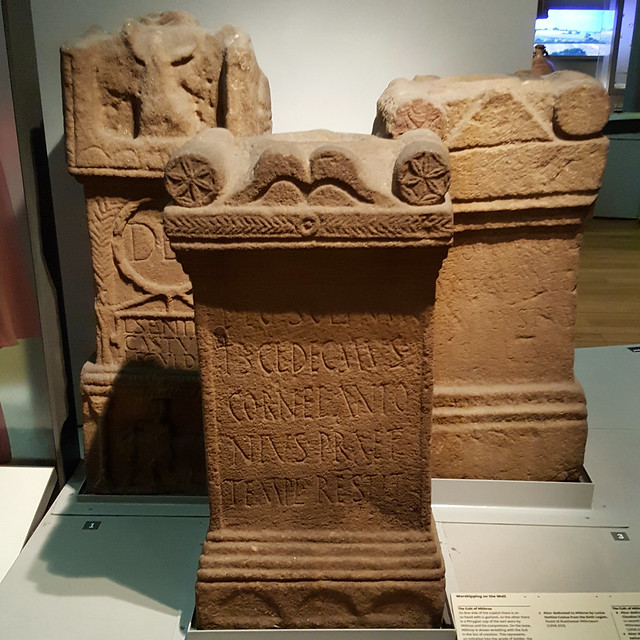
A second set of altars comes from the Carrawburgh Mithraeum. On the middle altar, Mithras carries the whip of the sun god. The altar still bore traces of green and red paint when it was found.
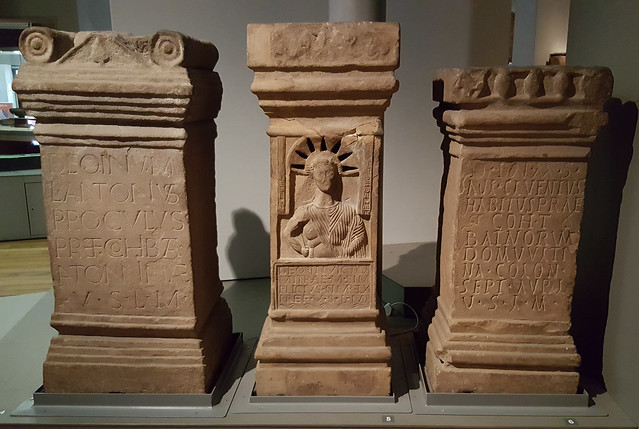
Indeed, you can still visit the Carrawburgh Mithraeum on the old military road. It lies just beyond a small car park before you reach Once Brewed.

This sort of tauroctony suggests what a Mithraeum might have displayed. The curve at the top represents the cave. This one came from the Housesteads Mithraeum.
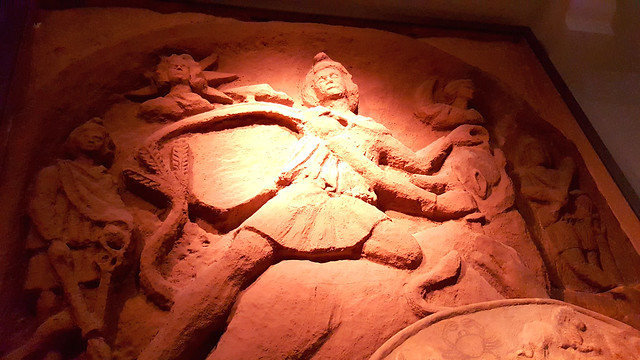
These altars also came from the Housesteads Mithraeum. Most legends say Mithras came from a living rock. Worshippers from the Easter Provinces thought he was born from a cosmic egg. These altars show that scene, and the signs of the Zodiac decorate the egg. According to the Great Museum North, “this is the earliest depiction in Britain of these signs as we know them today.”
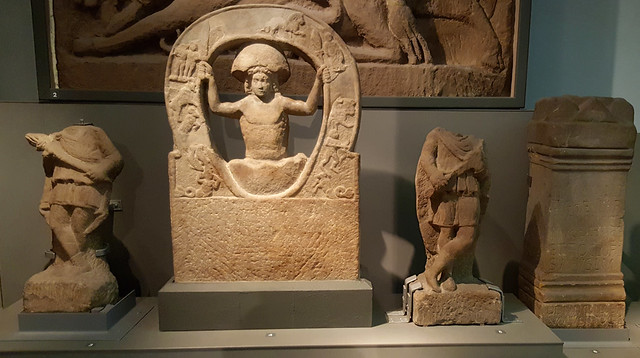
The Mithraeum in Antiquity
Some think the Mithraea were underground to represent the cave where Mithras killed a bull. They often stood near springs or streams, leading scholars to think fresh water played a part in Mithraic rituals. (I dread to think what his followers would think of the sorry state of the Walbrook now).
While we’ve been calling it a temple, that’s not strictly true. Romans saw temples as a place to connect with their god. They were open spaces, accessible both by initiates and newcomers alike. Mithraea couldn’t be more different, being hidden away and underground.
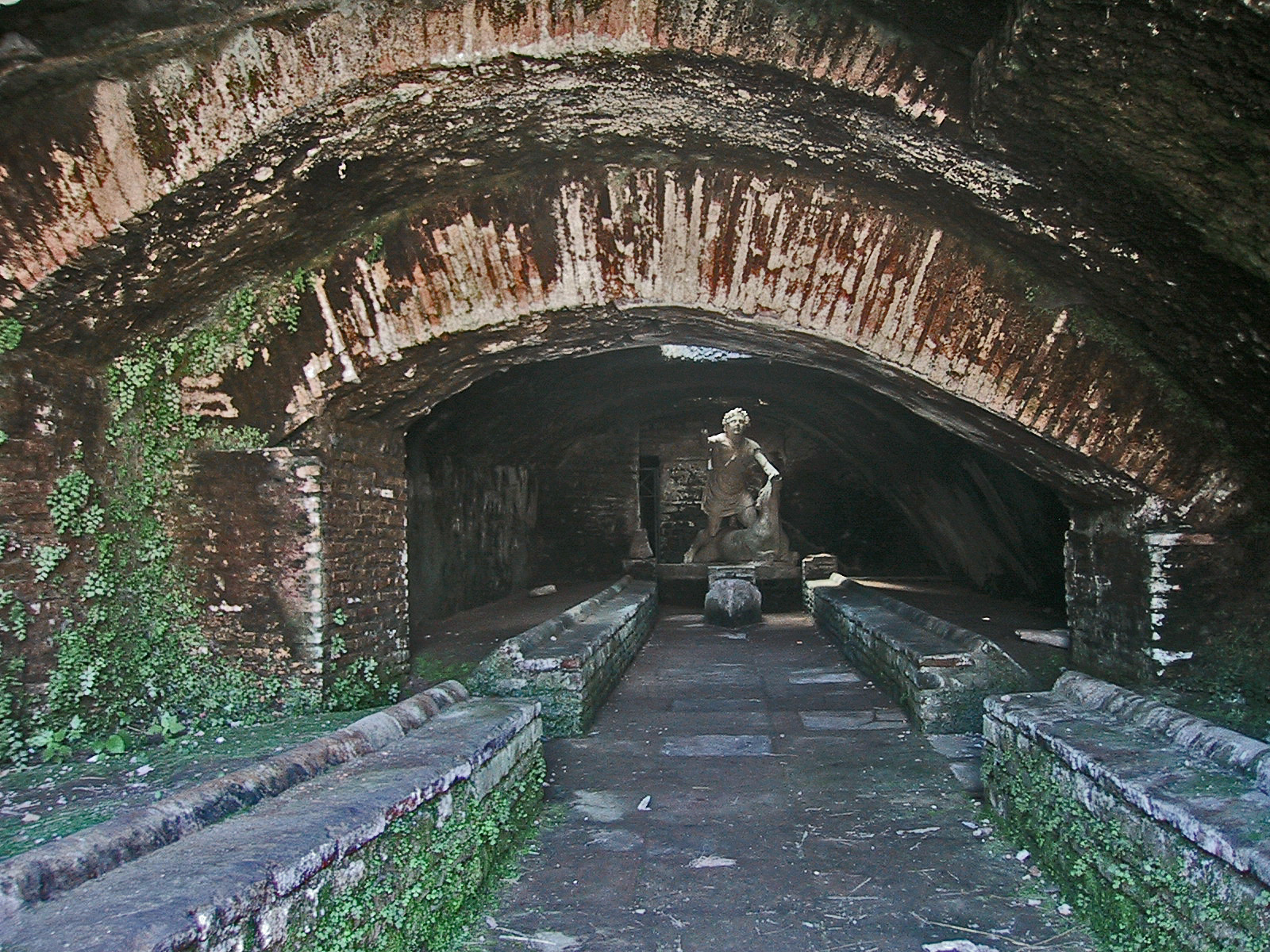
A mosaic at Ostia Antica shows the seven grades the initiates must pass through. A different planetary god protected each grade, from Mercury to Saturn. Some think their design was to mirror the Mithraen view of the cosmos, with Mithras at its centre (Wolfe 2017).
Seeing Mithraea elsewhere gives a better idea of what London’s Temple of Mithras might have looked like. But still…it’s nice to let the imagination roam!
Pay a visit if you can!
As you can imagine, the London Mithraeum is currently closed due to the pandemic. You can learn more from their free digital guide, Bloomberg Connects, available from Google Play or the Apple App Store.
When it is open, as it was in 2018 when I visited, it was free to visit, but you needed to book ahead to guarantee a place. Temple viewings happen every 20 minutes. But they only let limited numbers in to preserve the tranquillity of the experience.
Then pop up the road to the Guildhall to see the remains of the amphitheatre in their basement.
Enjoyed this post? Sign up below and I’ll let you know every time I post a new folklore article.
References
Beck, Roger (1987), ‘Merkelbach’s Mithras’, Phoenix 41:3, pp. 296-316.
Clauss, Manfred (2001), The Roman Cult of Mithras: The God and His Mysteries, trans. Richard Gordon, New York: Routledge.
Kennedy, Maev (2016), ‘Oldest handwritten documents in UK unearthed in London dig’, The Guardian, https://www.theguardian.com/uk-news/2016/jun/01/tablets-unearthed-city-glimpse-roman-london-bloomberg.
Ulansey, David (1991), The Origins of the Mithraic Mysteries: Cosmology and Salvation in the Ancient World, New York: Oxford University Press.
Vermaseren, M.J. and van Essen, C.C. (1965), The Excavations in the Mithraeum of the Church of Santa Prisca in Rome, Leiden: Brill.
Wolfe, Kerry (2017), ‘The Ancient Roman Cult That Continues to Vex Scholars’, Atlas Obscura, November 13, https://www.atlasobscura.com/articles/mithraic-mysteries.
Nutty about folklore and want more?
Add your email below and get these posts in your inbox every week.
You'll also get my 5-step guide to protecting your home using folklore!








The idea of physically moving an archaeological site, then moving it back (more or less) really amazes me. They’re not exactly portable!
I’m glad people saw to it that it got preserved so well. Thank you for the details and the photos!
Wow, lots of research done, loads of visuals. I love the idea of an underground ancient temple with Latin chanting- must be quite an experience. And that street-level guiding staircase is seriously cool.
Excellent article, images, and videos Icy – thank you! x
My pleasure!
Great post! I’ll definitely visit next time I’m in London:)
I’ve been fascinated by Mithras and his rites and temples since reading Mary Stewart’s Arthur series, many years ago. She wrote a very well researched depiction of his worship.
Fascinating post. Some of these motifs reach back to Sumerian myths. I can’t help but wonder the reason for the secrecy.
This was Wonderful and have seen so much on this for the first time I heard this!! Thank You So Much Dear Icy!!😘💖🌼🌺🌻💐🌞